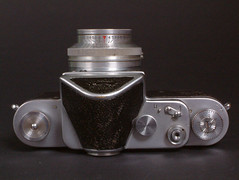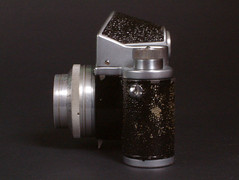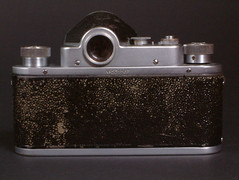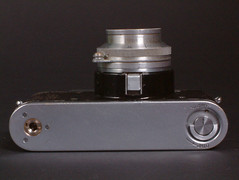Zenit 1
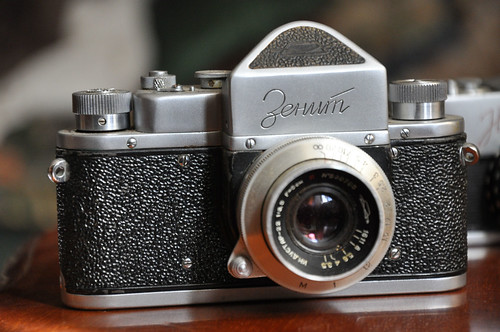
|
| Zenit 1 image by M*LoW - Massimo (Image rights) |
The Zenit (or Zenit 1) is a 35 mm SLR camera made by Krasnogorski Mekhanicheskii Zavod (KMZ) in Krasnagorsk near Moscow in the USSR, during the cold political climate of the early 1950’s. KMZ was established in 1941. This is the first model to use the 'Zenit' name, and the founder of a long dynasty. It was produced between 1952 and '56. It is a compact, robust and clever little camera based on the Zorki rangefinder which KMZ was already making (itself copied from the FED, which is a copy of the Leica II), but taken one step further to become an SLR with a fixed eyelevel pentaprism finder.
The lens mount is a 39 x 1 mm screw thread, the same thread as Leica-mount lenses, but the lens register (i.e. the depth of the camera from the flange to the film plane) is longer than in Leica rangefinders (in order to allow room for the mirror of the SLR). The result of this is that Leica-mount lenses will fit on the Zenit, but only focus very close up[1].
Like the Leica, Fed and Zorki, the Zenit is loaded through the base (a leader about 100 mm long must be cut at the start of the film, and attached to the removable uptake spool before inserting the film cassette and uptake spool in the camera). The removable base plate is identical in size to that on the Leica, but not interchangeable (it is identical to that on the Zorki of the same age). The outer body, including the mirror housing, is a one piece alloy casting, the top cover is in two pieces, while inside, the shutter crate is a separately cast unit. The shutter is a rubberised cloth focal-plane one, very like that on the Zorki rangefinder cameras.
The standard lens is an Industar-22, a 5 cm f/3.5 coated Tessar-type lens.[2] The lens has simple, manual aperture control, slightly inconvenient for an SLR camera; the user must either focus and frame with the lens stopped down, or take the camera away from their eye to stop down, after focusing.
KMZ was one of the early pioneers in the field of 35 mm SLRs, yet the Zenit was the ninth 35 mm SLR camera introduced, excluding a few exotic and scarce models, mainly from central Europe, and the second to appear in the Soviet Union[3], the first being the less familiar GOMZ Sport, which was one of the first production 35mm SLRs in the world. The better known of its contemporaries are the Asahiflex and the Contaflex. The camera's design is arguably rather basic; it lacks some features which became familiar on later SLR cameras. The mirror does not return instantly, for example; it returns as the film is advanced.
The Zenit, the name engraved in Cyrillic letters on the prism housing front[4][5], is the first in a long and popular series of cameras gradually evolving throughout the second half of the 20th century. The first improvement was to include flash synchronisation with the Zenit C[6]. A substantially different camera body with a number of improved features (the Zenit 3) was introduced in 1960. Its successors, the Kristall and the similar Zenit 3M, had lever film advance and a hinged back for easier film loading, at the expense of a somewhat larger body, perhaps fitting less well in the hand.
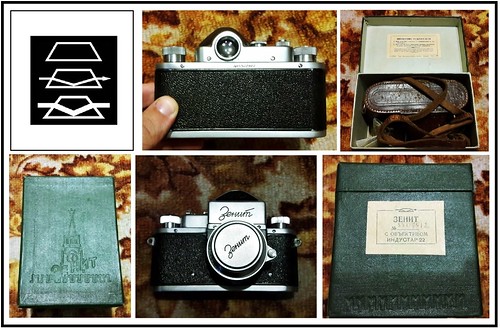
|
| image by schyter (Image rights) |
Specifications
- Type: 35 mm single-lens reflex camera
- Format: 24x36 mm on standard 135 cartridge film
- Manufacturer: KMZ
- Years of production: 1952-56[7]
- Number produced: Est. 39 019[7]
- Standard lenses: Industar-22 5 cm f/3.5
- Shutter: Cloth focal-plane shutter. 1/25 - 1/500 sec plus B. Cable release socket in shutter release button. No delayed action. No flash synchronisation.
- Viewfinder: Pentaprism viewfinder with ground glass focusing screen. No prismatic focusing aids. Mirror reset as film is advanced.
- Dimensions (width x depth x height): 140 x 50 x 90 mm (body only); depth with Industar-22 approx. 77 mm
- Weight: 540 g body only); 610 g with Industar-22.
| ||||||||
|
|
| ||||||
| ||||||||
| Images by Dustin McAmera. (Image rights) | ||||||||
Notes
- ↑ Leica-mount lenses may indeed be useful for close work: for example, the Industar-61 from a FED rangefinder, with the focus scale at infinity, focuses at about 25 cm when mounted on the Zenit. A Zenit lens mounted on Leica or Zorki focuses 'beyond infinity', and is of no use at all.
- ↑ See this and other lenses for M39 Zenit cameras, table archived the Internet Archive in 2021, formerly at Nathan Dayton's Communist Cameras.
- ↑ Yuri Boguslavsky (who trades in Soviet cameras as 'Fedka') states 'The camera was probably never exported'.
- ↑ Pre-production examples shown on the Zenit page at the KMZ Archive website zenitcamera.com have different styling.
- ↑ A pre-production Zenit, with the name in Cyrillic block capitals, and with a prototype Vega-1 5 cm f/2.8 lens, was sold at the sixth Westlicht Photographica Auction, in November 2004.
- ↑ Notes on the Zenits, archived at the Internet Archive in 2021, formerly at Nathan Dayton's Communist Cameras, state that examples of the Zenit 1 (also the Zorki 1d) exist to which flash synchronisation was added as a modification after purchase.
- ↑ 7.0 7.1 Production figures at the KMZ archive site show that very few were made in 1952, and most production was in '54 and '55.
